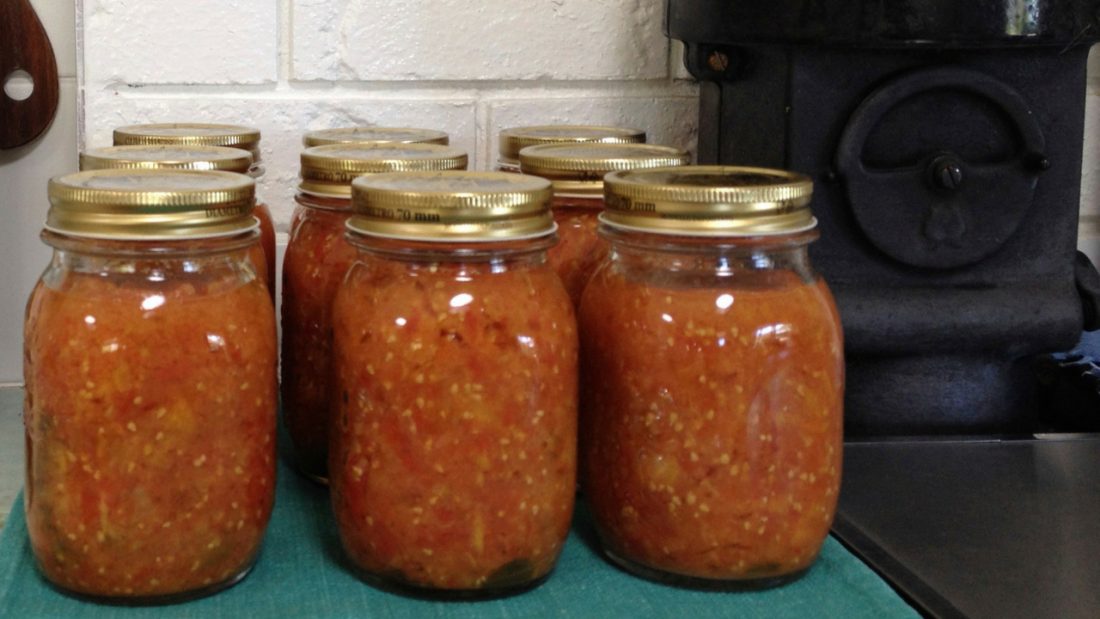Passata — Italian tomato pasta sauce
2 kg of vine ripened tomatoes make three 450g jars of passata
Require
- Sterilized jars and lids
- Funnel
- Strainer or colander
- Long handled tongs
- Large stockpot
Ingredients
Fresh vine ripened tomatoes
Fresh herbs
Raw sugar
Method
- Wash the tomatoes to remove dirt and grit.
- Blanch the tomatoes in boiling water for about 20–30 seconds. You will notice the skins starting to come away. Remove the tomatoes from the boiling water with the colander or strainer.
- The next step involves mashing the tomatoes (see notes below).
- Using tongs, place the sterilised jars onto your workspace. Place a few leaves of herbs into the jars. See ideas for herbs below. Also add a pinch of sugar to the jars (no more than ½ teaspoon per jar).
- Spoon the passata into the sterilised jars containing the herbs and sugar. Leave a gap of about 4cm from the lid. Secure the lids.
- Place the sealed jars into the large stockpot and cover with water. Depending on how much space you have in your pot, you may wish to fold a small towel into the base of the pot. This will help to prevent the jars hitting each other once the water starts to boil.
- Bring the water to the boil, and boil for 30 minutes.
- Once the water has cooled, remove the jars from the pot and allow them to cool overnight.
- Store in a dark, cool place. Passata may be stored for up to three years.
Sterilising jars and lids
Two options
- Place jars and lids in dishwasher for a hot wash cycle and allow to dry in the dishwasher or,
- Place jars and lids in a large pot of boiling water and boil for 20 minutes. Remove jars from the hot water with tongs and allow to dry the oven that has been preheated to 100oC.
Mashing the tomatoes for the passata
You can use a tomato press, food mill (moulis) or food processor. Each option will produce a different style of sauce. The tomato press or food mill allows for cleaner separation of the flesh, skin and juice. This means you have better control over how much liquid you leave in the passata. The food processing option blends all of the contents together, producing a sauce with a higher liquid content. The excess liquid is easily removed before or after preserving. I find that much of the liquid evaporates during cooking. Most recipes advise that you remove the skins, but I encourage you to leave these in the sauce to boost the colour and antioxidant content.
Passata herbs
There are no rules to the amount of herbs added to passata. As a guide I suggest the following options may be added to a jar:
- 1 – 2 basil leaves or
- 1 – 2 bay leaves or
- 1 sprig of marjoram or thyme (about 7cm long).
It is not essential to add salt to preserve the tomatoes, but you may add a small pinch. Additional flavour can be added when you cook with the passata.
Cooking with passata
You might be thinking that this is a lot of effort to make tomato pasta sauce when you can buy it already prepared. However, it is all in the flavour — there is no way of describing the superiority of homemade passata — you can only judge this by tasting it! Passata is an excellent way to use excess tomatoes. It is a very versatile ingredient for pasta sauces, soups, curries and casseroles.
